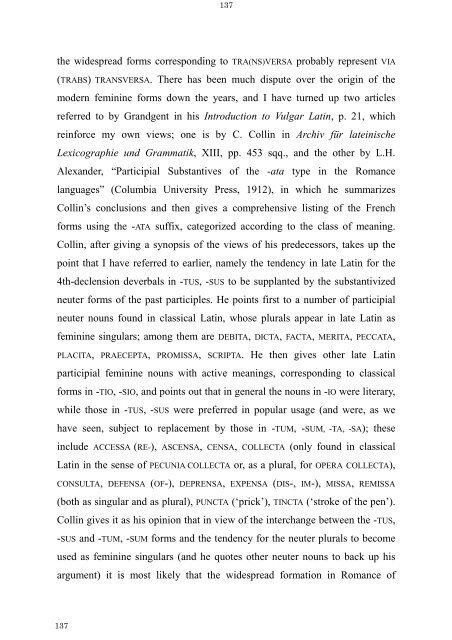The Latin Neuter Plurals in Romance - Page ON
The Latin Neuter Plurals in Romance - Page ON
The Latin Neuter Plurals in Romance - Page ON
Create successful ePaper yourself
Turn your PDF publications into a flip-book with our unique Google optimized e-Paper software.
137<br />
137<br />
the widespread forms correspond<strong>in</strong>g to TRA(NS)VERSA probably represent VIA<br />
(TRABS) TRANSVERSA. <strong>The</strong>re has been much dispute over the orig<strong>in</strong> of the<br />
modern fem<strong>in</strong><strong>in</strong>e forms down the years, and I have turned up two articles<br />
referred to by Grandgent <strong>in</strong> his Introduction to Vulgar <strong>Lat<strong>in</strong></strong>, p. 21, which<br />
re<strong>in</strong>force my own views; one is by C. Coll<strong>in</strong> <strong>in</strong> Archiv für late<strong>in</strong>ische<br />
Lexicographie und Grammatik, XIII, pp. 453 sqq., and the other by L.H.<br />
Alexander, “Participial Substantives of the -ata type <strong>in</strong> the <strong>Romance</strong><br />
languages” (Columbia University Press, 1912), <strong>in</strong> which he summarizes<br />
Coll<strong>in</strong>’s conclusions and then gives a comprehensive list<strong>in</strong>g of the French<br />
forms us<strong>in</strong>g the -ATA suffix, categorized accord<strong>in</strong>g to the class of mean<strong>in</strong>g.<br />
Coll<strong>in</strong>, after giv<strong>in</strong>g a synopsis of the views of his predecessors, takes up the<br />
po<strong>in</strong>t that I have referred to earlier, namely the tendency <strong>in</strong> late <strong>Lat<strong>in</strong></strong> for the<br />
4th-declension deverbals <strong>in</strong> -TUS, -SUS to be supplanted by the substantivized<br />
neuter forms of the past participles. He po<strong>in</strong>ts first to a number of participial<br />
neuter nouns found <strong>in</strong> classical <strong>Lat<strong>in</strong></strong>, whose plurals appear <strong>in</strong> late <strong>Lat<strong>in</strong></strong> as<br />
fem<strong>in</strong><strong>in</strong>e s<strong>in</strong>gulars; among them are DEBITA, DICTA, FACTA, MERITA, PECCATA,<br />
PLACITA, PRAECEPTA, PROMISSA, SCRIPTA. He then gives other late <strong>Lat<strong>in</strong></strong><br />
participial fem<strong>in</strong><strong>in</strong>e nouns with active mean<strong>in</strong>gs, correspond<strong>in</strong>g to classical<br />
forms <strong>in</strong> -TIO, -SIO, and po<strong>in</strong>ts out that <strong>in</strong> general the nouns <strong>in</strong> -IO were literary,<br />
while those <strong>in</strong> -TUS, -SUS were preferred <strong>in</strong> popular usage (and were, as we<br />
have seen, subject to replacement by those <strong>in</strong> -TUM, -SUM, -TA, -SA); these<br />
<strong>in</strong>clude ACCESSA (RE-), ASCENSA, CENSA, COLLECTA (only found <strong>in</strong> classical<br />
<strong>Lat<strong>in</strong></strong> <strong>in</strong> the sense of PECUNIA COLLECTA or, as a plural, for OPERA COLLECTA),<br />
C<strong>ON</strong>SULTA, DEFENSA (OF-), DEPRENSA, EXPENSA (DIS-, IM-), MISSA, REMISSA<br />
(both as s<strong>in</strong>gular and as plural), PUNCTA (‘prick’), TINCTA (‘stroke of the pen’).<br />
Coll<strong>in</strong> gives it as his op<strong>in</strong>ion that <strong>in</strong> view of the <strong>in</strong>terchange between the -TUS,<br />
-SUS and -TUM, -SUM forms and the tendency for the neuter plurals to become<br />
used as fem<strong>in</strong><strong>in</strong>e s<strong>in</strong>gulars (and he quotes other neuter nouns to back up his<br />
argument) it is most likely that the widespread formation <strong>in</strong> <strong>Romance</strong> of









